Making Napkin Dumplings
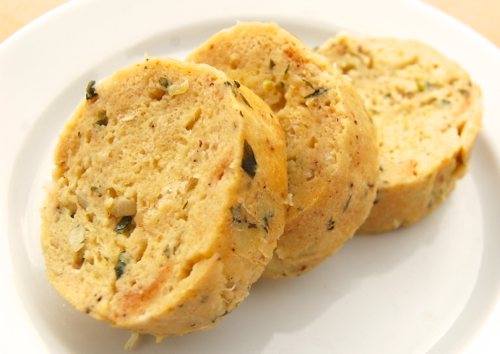
Of all the many uses for stale bread, napkin dumplings rank near the top. I remember the first time I was served these in a Bohemian restaurant in Berwyn, Illinois. I thought: where have these been all my life? Then immediately after that: please pass the gravy. Napkin dumplings are called napkin dumplings because they’re traditionally boiled in napkins. Here’s I’m using plastic wrap and foil, but honestly I think the traditional napkin method may be superior for reasons you’ll soon see.
Assemble all your ingredients and set a pot of water on the boil. Here I have about nine ounces of completely stale wheat bread, cubed with most of the crusts trimmed off. You can dry fresh bread cubes out in a 200-250-degree Fahrenheit oven if you wish. It takes about 40 minutes. Try not to let them brown if you can help it. Anyway, pour them into a large bowl.
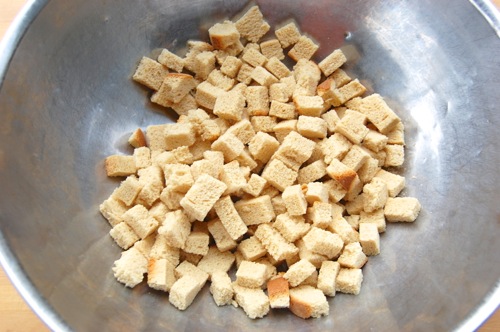
Next combine the mined onion and butter in a sauté pan. Sweat the onions over medium-low heat until they’re soft and translucent, but again, not browned.
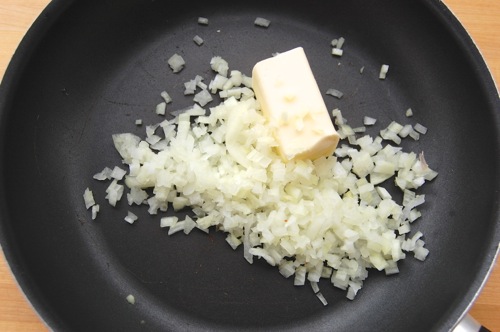
Add the parsley and cook another 30 seconds or so.
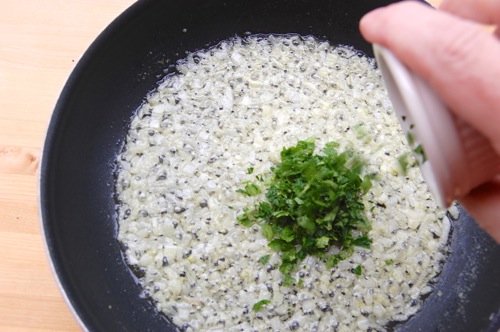
Pour that mixture over the bread cubes, then add the salt, pepper and nutmeg.
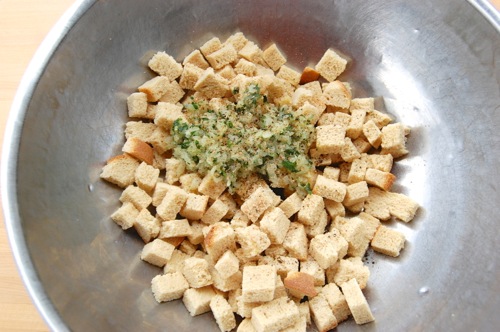
Toss that.
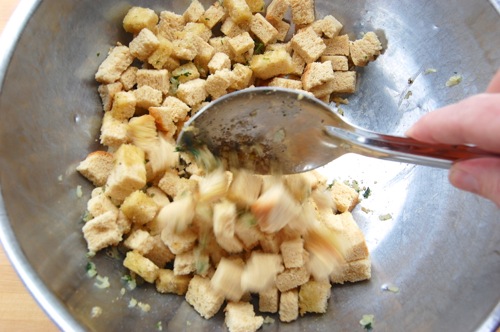
Now combine the eggs and milk in a bowl.

Wreck’em.
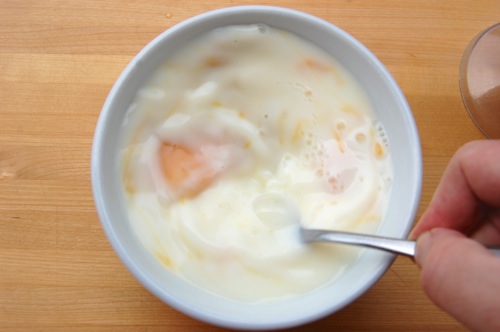
Pour that into the bowl.
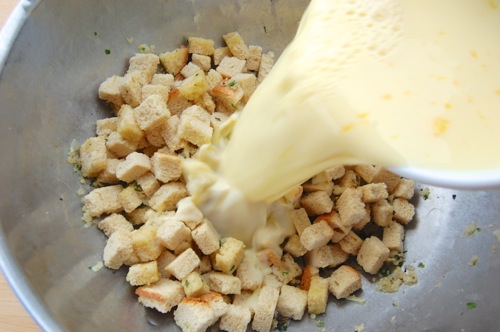
And begin to toss.
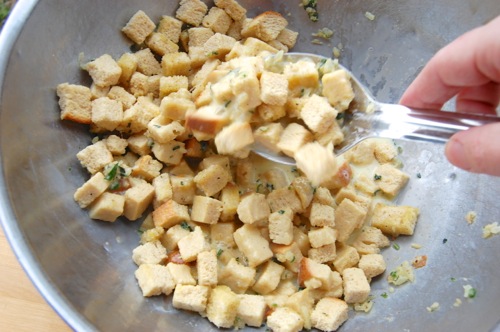
It’ll take about two minutes of tossing for the bread to soak up the egg mixture. Set that aside.

Now then, lay down a linen napkin or two sheets of plastic slightly overlapped.
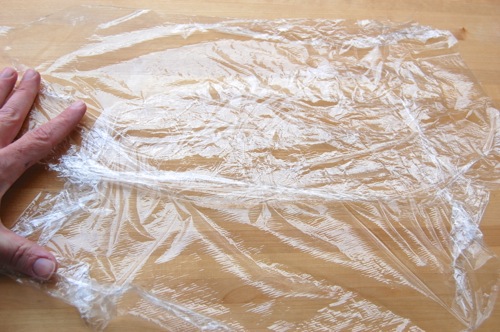
Spoon on half the bread mixture.
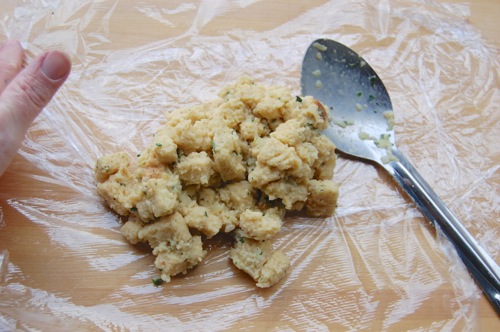
Roll it up.

Twist one end and tie it.
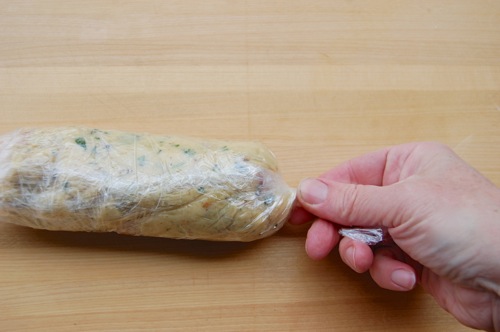
Squeeze the filling a bit so it compacts some, and tie it. My mistake here was tying this too tight and not allowing for expansion. Ah well, when it comes to being a Bohemian housewife I’m a rookie.

A layer of foil is important here to help keep the shape should the plastic burst (and it did). Plop the whole thing into boiling water for about 40 minutes.
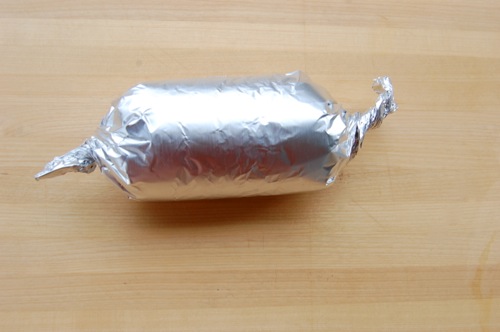
Here you can see mine plumped quite a bit as it cooked. That plumping caused it to burst the plastic, which was no big deal except I had to make sure I got all the little shreds of plastic off before I served them. Convenient as this was, next time I think I’ll do it the old-fashioned way.
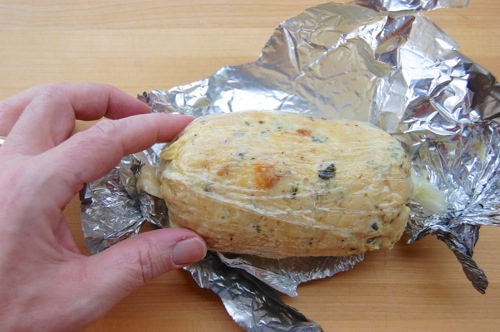
Slice and serve warm.

You know I’m glad I did these today. Because if the world is going to end, I can’t think of a better way to go out than with a mouthful of Czech bread dumplings and gravy. Can you?
Well that’s interesting! I’ve never heard of these and, in all candor, they look much more inviting than they sounded a day or two ago.
Looks almost like a bread sausage tho I suppose it’s closer to polenta allowed to set up. Could you grill it like polenta?
In any case, thanks so much for introducing this interesting new — to me — idea.
Hey Rainey!
Glad to hear you might be a convert to napkin dumplings! These are more like turkey stuffing than anything, but the slices could be toasted, over a grill if you like, or browned in a pan wit a little butter. I do that with leftovers.
Cheers and Merry Christmas!
– Joe
Fascinating Joe. Boil this in a cloth and it’s a dumpling, bake it in a bird or pan and it’s stuffing or forcemeat (at least in England).
Rachel!
WONDERFUL to hear from you! I’ve been think about you this season…have you been in Kentucky at all? And your book, when does it come out?
To your point however, indeed it is stuffing or forcemeat, just in a napkin. I’ve been musing as to whether this qualifies it as a white pudding technically. My feeling is that it does. What’s your opinion?
Again, so good to be in touch!
– Joe
Time to make some sví?ková!
Indeed…Chicago style!
Oh, you’re making me homesick.
– Joe
I’ve been to Prague twice and these are absolutely to die for. They are usually accompanying a supertasty roastbeef with gravy. I always ordered this dish, no matter where we went to eat. Imagine eating it in a 16th century vault, washed down with a local beer.
Isn’t Prague a lovely city? Probably my favorite in Eastern Europe. I know those little beer halls well. (Ehem).
Tanks for the memories, Anna! Merry Christmas!
– Joe
I want to know whether the onion mines are in Moravia or Bohemia. And why I forgot the leftover bread from our office party — I meant to take it home especially to make bread pudding of one kind or another.
Hang on…onion mines? Never heard of that but can’t wait to go!
Better luck next time on the bread, but I’ll bet there’ll be plenty left after the holidays! Cheers, and Merry Christmas!
– Joe
Looks tasty.. Maybe I’ll add them to Christmas Eve dinner. 🙂
Let me know how you like them if you do!
– Joe
Though I have been thought of to have bohemian behavior in my life I have to say these are new to me but they sound amazing and delicious. Would layers of fine cheesecloth versus the plastic wrap work?
They sure would, Linda. Nice idea!
– Joe
Are you talking about Czech Plaza on Cermak? 🙂
Actually it was at Klas, a little further down…I guess that’s really Cicero isn’t it? My mistake!
I may have to go there when we’re back home this coming week! Merry Christmas!
– Joe
Yes, that’s Klas in Cicero…they’re still there! Check their hours, though…I think they’re not open as much as they used to be. (Maybe only on weekends.)
I’ll see if I can get there, though at the moment I’m still in Louisville, down with the flu, darnit. If I live I’ll go get me some of those dumplings!
– Joe
Joe – I’m so sorry you have the flu and hope you are better soon. Dumpling update – they were perfect!! I did make them for our turkey dinner and I can tell you that I will never bother with stuffing again. They were exactly as I remembered them except for the shape as mine were wobbly and not round. I couldn’t bring myself to use my grandmother’s antique linen napkins so I used plastic wrap and foil but I plan to visit the fabric store and get a piece of non-antique linen to use next time. Thanks so much for showing me how to make these. They were heavenly and so easy to do.
So glad to hear that, Linda! That’s really great. You never know with something like stuffing….recipes vary so much, I feel quite lucky that I got so close to what you remember. I’m most gratified by the knowledge!
As for the shape, I’m sure there’s a midpoint between too tight and not tight enough with the wrapping. A decent-sized piece of linen will certainly fix that. Best of luck refining your technique, and again, I’m very pleased to have helped!
Also, the flu seems finally on the wane.
– Joe
These are similar to the Semmelknoedel that my Austrian mother-in-law makes. She just adds a little flour after the bread has soaked for a while and forms balls that are boiled without any wrapping. The flour is necessary to keep the knoedel intact. I know because I left it out once… just once. Her sister makes Serviettenknoedel just like the ones you describe here.
Ah, excellent! Thank you, Andrea! I didn’t know the name of those, but another reader asked about them. I’ll have to give them a try sometime soon. Thank you mucho!
– Joe
Hi Joe!
Thanks for a wonderful recipe!
I just want to know if I can replace the bread chunks with cooked rice or soya granules soaked in milk and just add whipped eggs? Basically, I’m allergic to yeast hence can’t use bread. I am stuck with stuffing ideas too. So this seems like a good solution if I can find a substitute.
Would really appreciate it if you could help.
Hi Vrushali!
There’s only one way to find out: try! I think the rice idea with the whipped whites will work. Many napkin dumpling recipes call for whipped whites, and they may be just the thing to bind the mixture. You can experiment by coating small balls of the mixture lightly with flour, then dropping them straight into the boiling water without any sort of form. Many Bohemian dumplings are made in just this way. If they fall apart, add a little more egg to help hold them together!
– Joe
Thank you so much. Will try and let you know for sure.
Hi, Vrushali, many Czech boxed dumpling mixes have rice crispies instead bread cubes in them, boiled rice would probably give them really strange texture. And yes, egg whites should be beaten before adding them, the dumplings are all about being fluffy and a real edible sponge.
Joe, have you tried the modern approach to cooking them- in the microwave? They are stars of Czech cookbooks and much easier than the fuss with the cloth thing. Grease well plain china cups, fill them with the mix and put them to a microwave oven together with a cup of warm water to produce steam. Cook on high for 7-8 minutes or until the inserted toothpick comes out clean.
Fascinating, Alex! Thanks for the very interesting tips. I didn’t find much difference between beaten egg whites and whipped egg whites in my own experiments here, but I did find several recipes that called for whipped whites. Perhaps I should keep fiddling. I’ll have to try the microwave version one day soon. That’s excellent.
– Joe
Foolproof Microwave Dumplings: For 1 cup (a.k.a.) one person :
1 slice of stale bread ( approx 3/4inch)
1 egg (separate yolks and whites)
approx. 1/3 cup milk
2 tablespoons flour+ 2 teaspoons semolina ( to imitate Czech special dumpling flour)
pinch of salt
parsley
butter for greasing your cups
Cut bread slices to 1/2 inch cubes. Separate yolks and whites. Mix yolks and milk, pour it over bread cubes. Let soak for a moment. Whip whites with salt, actually it does not matter if they are whipped or just beaten, but you (us) want the result to be fluffy, remember? This is what makes them different from stuffing. Mix whites and flour gradually to soaken bread, add chopped parsley. The mix should be sort of gooey with clearly visible chunks of bread Melt butter in one of the cups and grease all cups really well. Divide the mix to prepared cups and let them cook in the microwave for approx. 7 minutes. Don’t overfill them, the dough will walk up when cooked. Together with cups with dough put one cup of warm water to the microwave- to create steam. The dumplings are done when an inserted toothpick comes out clean. Remove your dumplings from the cups and let them sit for a while to let the steam go out. Cut in slices with a thread. The portions are quite big, actually. If some dumplings remain, cut them to cubes and make scrambled eggs with cubed ham and dumplings- a star of Czech leftover cuisine 🙂
Outstanding…thanks so much Alex!
– Joe
Hi Vrushali,
Just wanted to let you know that Alex put up an interesting reply to your question!
– Joe